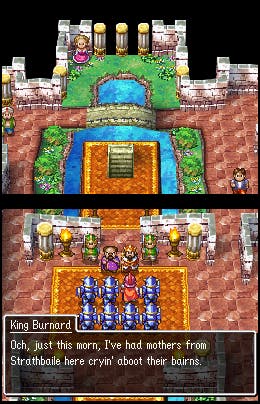Dragon Quest IV: Chapters of the Chosen
Blue in the face.
In a JRPG landscape filled with identikit teenage protagonists, indistinguishable blacker than black antagonists and drab, clinical futuristic cityscapes, Dragon Quest IV is a deep breath of fresh air. This is, after all, a game in which you begin by assuming the role of a blue-mustachioed soldier in his fifties, a man who speaks in a thick, near-indecipherable Scottish brogue.
Ragnar McRyan is in no way a character designed off the back of some intense Japanese schoolgirl demographic focus testing. He is not aspirational. He does not wear a fussy, frilly shirt, unbuttoned halfway to reveal an over-designed amulet nestled betwixt stony pecs. He will never be a poster boy for a Dragon Quest Mountain Dew ad campaign in downtown Shibuya. He has a blue moustache.
A man approaching retirement, Ragnar is all tufty grey hair and regional accent, on a mission to catch a peeping tom and track down some missing children. And my goodness, for a game that was first released 18 years ago onto the NES it's a piece of anti-hero casting that feels braver and more interesting than pretty much any that's happened in the genre since. Doesn't that speak depressing volumes?

Better still, Ragnar is but one face in an ensemble cast that continues to buck expectation. The titular chapters exist beyond mere metaphor. This is a game literally divided into segments, each one focusing on a different character: the Russian tomboy and Tsarevna, Alena, the overweight trader Torneko, a man who decides late in life it's time to make his fortune as the greatest merchant in all the world and the twin sisters Maya and Meena, out to avenge their father's assassination.
Then, in the fifth and (almost) final chapter, each of these narrative threads string together as the chosen unite as a team behind you, the hero character. It's an excellent conceit, one that no doubt contributed to the diversity of the protagonists. After all, if you have the luxury of telling five different tales in your game, you can afford for one of them to be about Ragnar McRyan and his blue moustache.
At an hour or three apiece, the first four chapters are relatively brief, but this again contributes to rich and interesting feel: nothing is protracted so far as to become tiresome. The story is smoothed over by another solid translation from Square-Enix, whose recent localisation work on the Dragon Quest series has been exemplary. The diversity in accents (there are 13 dialects represented) lends the game world a real sense of geography, something that many JRPGs fail to do with their all-American voiceover casts.


